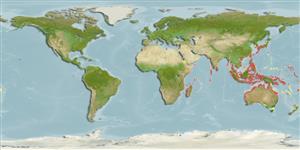Common names from other countries
Environment: milieu / climate zone / depth range / distribution range
Ecología
; salobre; rango de profundidad 0 - 4 m (Ref. 100954). Tropical
Indo-West Pacific: from East Africa, to Melanesia; north to Japan, and south to southern Queensland.
Length at first maturity / Tamaño / Peso / Age
Maturity: Lm ? range ? - ? cm Max length : 4.0 cm SHL macho / no sexado; (Ref. 349); common length : 3.0 cm SHL macho / no sexado; (Ref. 349)
Locally collected by coastal people. Shell used in shellcraft (Ref. 349). From high intertidal zone to shallow subtidal depths (Ref. 349, on rocks (Ref. 799). Part of both epibenthic and arboreal communities in mangrove areas (Ref. 128397).
Life cycle and mating behavior
Madurez | Reproducción | Puesta | Huevos | Fecundidad | Larva
Members of the order Archaeogastropoda are mostly gonochoric and broadcast spawners. Life cycle: Embryos develop into planktonic trocophore larvae and later into juvenile veligers before becoming fully grown adults.
Poutiers, J.M. 1998. (Ref. 349)
IUCN Red List Status (Ref. 130435)
CITES status (Ref. 108899)
Not Evaluated
Not Evaluated
Threat to humans
Harmless
Human uses
Pesquerías: comercial
| FishSource |
Herramientas
Más información
Age/SizeCrecimientoLength-weightLength-lengthMorfologíaLarvaAbundancia
Fuentes de Internet
Estimates based on models
Preferred temperature
(Ref.
115969): 21.7 - 29.3, mean 28.4 (based on 2627 cells).
Vulnerability
Low vulnerability (10 of 100).
Price category
Unknown.
